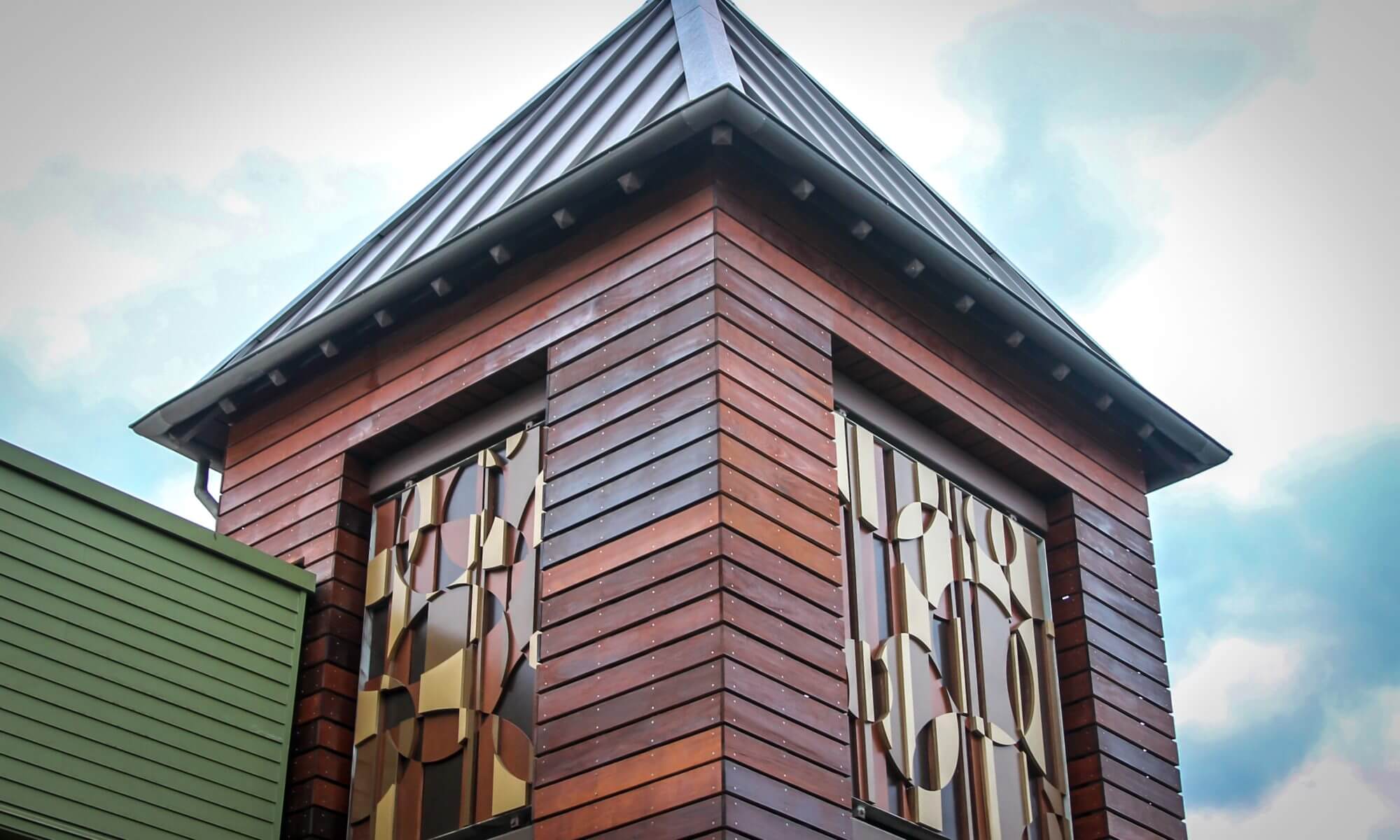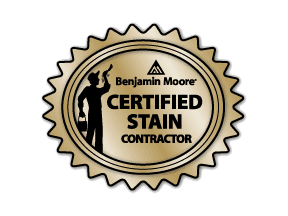
Yesterday, I had the opportunity to advance my education in the painting and coatings industry, specifically in the staining of exterior wood surfaces, by completing my training with Benjamin Moore Paints and becoming one of their Certified Staining Contractors. A couple of years ago, Benjamin Moore introduced a new line of exterior stains called ArborCoat which is a Premium Waterborne Exterior Stain System. It is an advanced technology that combines the penetrating attributes of a traditional oil based (alkyd) stain with the more durable and longer-lasting surface coat of a water based (acrylic) stain.

After completing an online course that introduced me to their staining products, I attended their advanced training session with Jorge Preciado, one of the ALLBRiGHT 1-800-PAINTING Crew Leaders who do a lot of our custom stain work for both interior and exterior. The session was taught by a very knowledgeable Benjamin Moore trainer with many, many years of experience in painting and staining. I knew the basics about staining, but I had no idea what I didn’t know about staining!
Here are a few highlights of what I learned and may help you with any of your exterior stained surfaces:
1. The Enemies Of Any Wood Surface Are Moisture And UV Exposure From The Sun
The goal of any stain is to show the natural beauty of wood while protecting it from moisture and sun exposure.
2. How A Deck, Patio Cover, Or Wood Siding Is Constructed Or Installed Has A Lot To Do With How Well A Stain Job Will Perform
Poor design will not be overcome by a coating system, so when building a deck or patio cover, go with a contractor with plenty of experience and one who knows the best designs and construction to prevent future stain failure and eventually rotting. For example, orienting a deck board crown side up and having at least a ¼” spacing between the deck boards will allow for proper drainage of moisture and prolong the life of your deck.
3.Back Staining, Or The Process Of Staining Or Coating All Sides Of The Wood Before It Is Installed, Is Essential.
Completely sealing a piece of wood with at least one coat of primer or stain will keep moisture from entering the wood and causing premature failure. If you install a piece of wood to another piece of wood and you didn’t stain all sides of both pieces first, then the areas where the two-piece touch will never be sealed since the painter can get in between the two pieces of wood after they are installed.
Wood decays in three ways:
- Delamination – multiple cycles of expanding and contracting due to wet and dry conditions causes the wood fibers to eventually expand and stay expanded. You see this type on the ends of boards that swell up and then never shrink back down. Keeping the wood sealed and protected will prevent this from happening.
- UV Decay – UV rays break down Lingin, the natural “glue” in all wood that holds all the wood fibers together. Unprotected wood will eventually break down and the grain will get rough and wood fibers will become loose. A stain with good UV protection will slow this process down and annual or bi-annual maintenance coats are necessary.
- Microbial Decay – Basically “rot”. Three things are necessary in all organic material to begin the cycle of decay. Heat, water, and oxygen. We can’t do too much about the heat since we can’t control the weather, but we can control the moisture intrusion with proper design and construction and we can seal out the oxygen with a quality stain that is maintained. Rot is to wood-like rust is to metal. Keep the moisture and oxygen away from metal and it will dramatically slow down the rusting process. The same goes for wood.
Here in California, traditional or conventional oil-based stains are all but gone and the ones left that do meet the VOC environmental requirements typically have had all the quality ingredients removed from them making them not as durable. The answer to that is a waterborne stain like ArborCoat. It is actually a hybrid of acrylic and alkyd technology that is very easy to use and cleans up with soap and water. It has very good color retention thanks to Benjamin Moore’s new line of all water-based tints call Gennex.
4. 80% Of Stain Failure Is Due To Improper Preparation
Even brand new wood surfaces require some prep. Things like mill glaze and surface contaminants will prevent a stain from bonding to the wood. Mill glaze is a surface barrier that forms on wood during the milling process that interferes with the adhesion and penetration of the stain. It is actually created by the heat of the friction during milling caramelizing the natural sugars in the wood. This can sometimes be seen as a shiny film on the surface of the wood. You can check for mill glaze by putting a drop of water on the wood. If it beads up, there is mill glaze. If it soaks in, then so will your stain. Mill glaze has to be removed before staining or the stain will not penetrate properly. It can be removed by sanding or applying a chemical agent that breaks it down. These things take time and time is money. Keep in mind, a lower-priced estimate from an inexperienced or uneducated contractor will typically not allow for this to be done.
5. Severely Failing Existing Stains Or Clear Coats, Dirt, Contaminants, Mold, Mildew, Etc. All Have To Be Removed Prior To Applying The New Stain.
This can be done by sanding and scraping or by using chemical products. Today, these products are biodegradable and safe for surrounding plant life. “Remove”, “Restore”, “Brighten” and “Clean” are all products by Benjamin Moore that will help ensure that your previously stained surfaces will be ready to receive the new stain and make sure is lasts. Again, doing this step takes time but it will pay off in the long run.
6. Annual To Bi-Annual Maintenance Is A Must To Make Your Initial Investment Last
A quick clean and recoat every so often will keep your stained woods looking nice making them last for years and years. Unfortunately, most homeowners skip this step and they let the stain degrade past a point where a maintenance coat will do the trick and then end up having to strip and restain all over again, which is much more costly.
A little money spent each year will be far most cost-effective in the long run than a complete strip and stain every 3 to 5 years. Plus, stained surfaces that are not maintained will rot or decay, and then it will cost you more to have the wood replaced. Setting up an annual maintenance plan with your painting contractor would be a great idea. ArborCoat has a clear coat that goes over their stains that literally only has to be cleaned with their “Clean” solution product and rinsed with water before it can then be recoated with the clear coat. No scraping, no sanding, just clean and recoat. Very easy and cost-effective to do each year. A homeowner could even do it themselves if they wanted to. The clear coat preserves the color and finish of the stain and acts as a “sacrificial” coating that is reapplied every year to year and a half. It contains a small amount of wax that also helps with preventing moisture intrusion.
Next week, I will be putting the finishing touch on our certification by attending Benjamin Moore’s final class in the certification process that has to do with managing expectations of stains with customers and problem solving existing stain failures. We will also be covering how to apply stains to the new synthetic wood products that last a long time and require very little maintenance, but don’t always look so nice.
